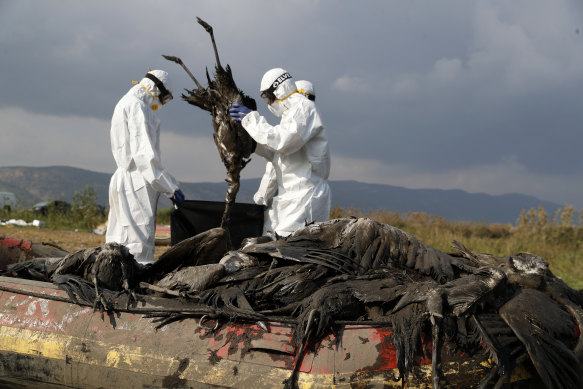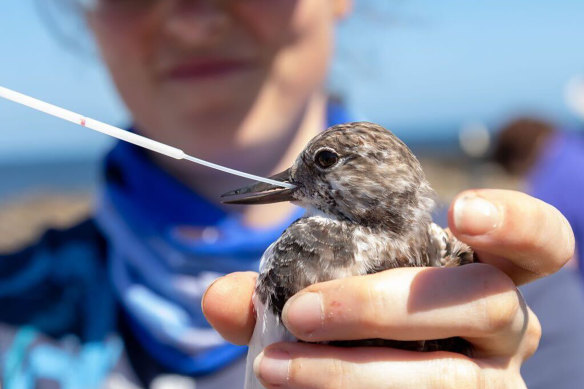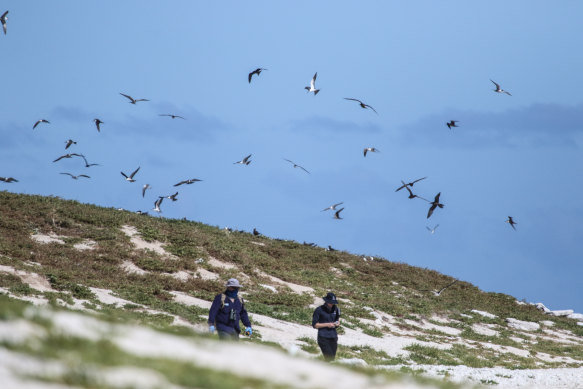This was published 4 months ago
Wildlife emergency: Australia prepares for bird flu onslaught
By Mike Foley
Environmental officers will soon be vaccinating wild populations of endangered animals against an inevitable outbreak of deadly bird flu, breeding captive “insurance” populations of threatened species and picking up carcasses to limit the spread of the disease.
These are the unprecedented actions Australian governments are preparing for under a new $100 million funding package to prepare for what experts say is an inevitable outbreak of a deadly variant of bird flu, known as H5N1, which has decimated wildlife on every continent except Australia.

Workers dispose of dead cranes at the Hula Lake conservation area in northern Israel.Credit: AP
“We are extremely worried about this variant of bird flu,” federal Environment Minister Tanya Plibersek said. “We know it’s in Antarctica now. We know it’s in Indonesia. We’re the last continent that this variant hasn’t hit. We’re doing our very best to prepare for it, but the simple truth is we can’t keep it out of the country. It’s likely to have potentially catastrophic impacts on our wild animals.”
Despite warnings, the government had previously committed just $7 million to prepare for an outbreak of H5N1. But last week conservation groups welcomed a new $100 million funding package, with hopes that planning is now under way in earnest. More may be added to the bill as preparations continue.
A study released in the journal Genome Biology last year sequenced the black swan genome and found it is “extremely sensitive” to the H5N1 strain, warning that an outbreak would put black swans in “significant peril” of extinction. But it is so far the only study that has looked in detail at the risks to Australian animals.
“With Australian marsupials – we don’t know whether they will be more, or less, susceptible to transmission,” Plibersek said. “We’re trying to make sure that we can get as much information as we can about any uniquely Australian responses to this variant of bird flu. The saddest and most important lesson is that it is likely to lead to mass mortalities, so insurance populations of animals are particularly important.”
“Insurance populations” are captive-bred groups of rare species that are maintained to ensure that if wild populations go extinct, it might be possible to reintroduce them. Current insurance populations include orange-bellied parrots, swift parrots, koalas and Mallee emu-wren, but it is likely that new species will be added to the list.
It has not been determined exactly how the animals will be vaccinated, or which species will be selected. However, it is expected to be targeted at species most likely to suffer damage, such as Tasmanian devils, which may contract the virus by eating dead birds.
In North America there is a program to vaccinate the world’s largest bird of prey, the endangered condor, as well as penguins in South Africa and ground-nesting birds in New Zealand.
Invasive Species Council advocacy director Jack Gough said wildlife experts were forecasting a crisis in which entire species of native birds and mammals could be wiped out forever.

Governments are preparing a vaccination program for wild bird populations.
“The suggestion that this could be the worst single environmental disaster in Australia’s history is probably not far off the mark,” Gough said. “The reality from overseas has been devastation of wildlife populations. The key to stopping that happening will be preparation and prioritisation, because we will not be able to stop the disease causing widespread damage.”
An ongoing outbreak of bird flu is spreading among farmed poultry and contributing to egg shortages for consumers, but the risk to human health remains low. The people most likely to be infected are livestock and poultry workers. Vaccines are available for anyone who contracts the virus.
A different and more deadly strain, known as H5N1, has spread into wild bird populations and the most likely source of infection in Australia may be the spring migration of birds from south-east Asia. Since the virus hit South America in 2022, 30,000 sea lions died, as well as 18,000 southern elephant seal pups. Half of Peru’s pelicans were dead within a few months of its arrival. If damage on this scale were repeated here, the 12,000 Australian sea lions left in the world would be wiped out.

Field workers have been deployed across Australian wetlands to look out for a dangerous strain of bird flu in migratory birds.Credit: Guy Weerasinghe
Gough said it was regrettable that Australia had not acted on warnings earlier because “only luck will allow us to avoid it this spring”.
“Extinctions happen slowly – until they happen fast. This could be the accelerator event that tips a whole bunch of species over the edge. I don’t think governments have quite grasped the workforce pressure that is going to come on their departments.”
Gough said the government’s $100 million funding package was a “serious response”, but more finance would be needed soon to expand preparations.
Start the day with a summary of the day’s most important and interesting stories, analysis and insights. Sign up for our Morning Edition newsletter.